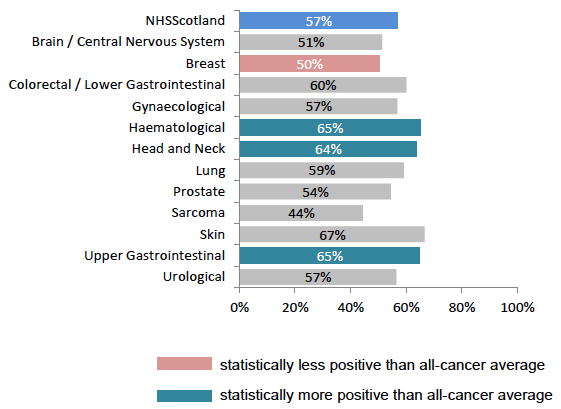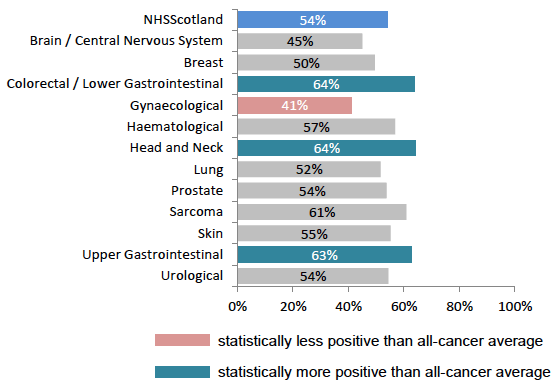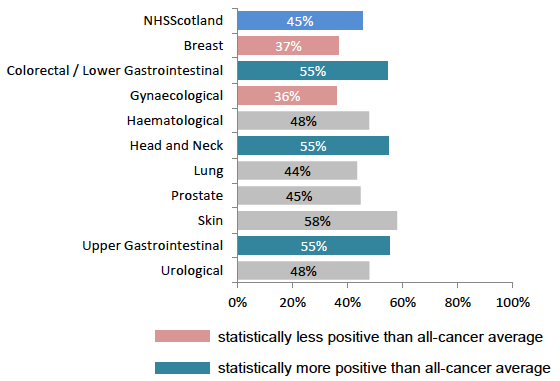Scottish Cancer Patient Experience Survey 2015/16
Results from the 2015/16 Scottish Cancer Patient Experience Survey. The survey covers the full care journey that a cancer patient experiences, from thinking that something might be wrong with them to the support they received after their acute-care treatm
This document is part of a collection
Home Care and Support
Both during and after treatment most patients will require help and support at home from family and friends. For others to help with cancer patients' care, adequate information is needed.
Similarly, many patients will need to access health and social care services (such as district nurses, home helps, and physiotherapists) both during and after treatment. Feeling adequately supported and cared for by these services is vital for both a positive care experience while in hospital and for the transition out of the hospital care setting.
Information to family and friends to help care for patient at home
Patients were asked whether doctors or nurses gave their family or someone close to them all the information they needed to help care for the patient at home.
Sixteen per cent of patients responded that either there were no family or friends involved, or their family of friends did not need information.
Of the patients that did want their family or friends to have information to help care for them, one in five (20%) reported that doctors or nurses did not provide this. A further 23 per cent of patients responded that this information was only received 'to some extent' (Table 43).
Table 43: Information to family and friends to help care for patient at home
| Did the doctors or nurses give your family or someone close to you all the information they needed to help care for you at home? |
n |
% |
|---|---|---|
| Yes, definitely |
2,196 |
57% |
| Yes, to some extent |
876 |
23% |
| No |
783 |
20% |
| Total |
3,855 |
100% |
Patients with breast tumours (50%) were statistically below the all-cancer average in reporting that doctors had given someone close to them the information they needed to care for the patient at home. Patients with haematological and upper gastrointestinal tumours (both 65%) were statistically above average (Figure 35).
Figure 35: % reporting information provided to family and friends to help care for patient at home, by tumour group

Support from health and social services during treatment
Patients were asked whether they were given enough support from health or social services during their cancer treatment. Forty-two per cent of patients responded that they did not need such support.
Of those patients that did need it, a quarter (25%) reported that they did not receive enough support during their treatment. A further 21 per cent of patients only responded that they received enough support 'to some extent' (Table 44).
Table 44: Support from health and social services during treatment
| During your cancer treatment, were you given enough care and support from health or social services (for example, district nurses, home helps or physiotherapists)? |
n |
% |
|---|---|---|
| Yes, definitely |
1,430 |
54% |
| Yes, to some extent |
555 |
21% |
| No |
660 |
25% |
| Total |
2,645 |
100% |
The only tumour group statistically below the all-cancer average for this question was patients with gynaecological tumours (41%) (Figure 36).
Figure 36: % receiving enough support from health or social services during treatment, by tumour group

Support from health and social services after treatment
Patients were also asked whether they were given enough support from health or social services after their cancer treatment.
Over half of patients (54%) responded either that they did not need support, or they were still receiving treatment.
Of those that did need it, around a third of patients (32%) reported that they did not receive enough care and support after their treatment. A further 23 per cent of patients only responded that they received enough support 'to some extent' (Table 45). These results are less positive than those for the question regarding care and support during treatment.
Table 45: Support from health and social services after treatment
| Once your cancer treatment finished were you given enough care and support from health or social services (for example, district nurses, home helps or physiotherapists)? |
n |
% |
|---|---|---|
| Yes, definitely |
953 |
45% |
| Yes, to some extent |
476 |
23% |
| No |
672 |
32% |
| Total |
2,101 |
100% |
Figure 37: % receiving enough care and support from health or social services after treatment, by tumour group

Patients with colorectal / lower gastrointestinal, head and neck, and upper gastrointestinal tumours were all statistically above the all cancer average for receiving enough care and support from health or social services (all had 55% responding 'yes definitely') (Figure 37)
Contact
There is a problem
Thanks for your feedback